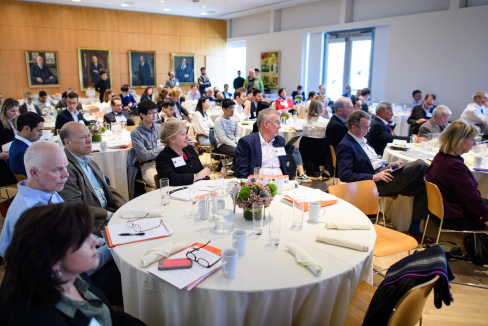Principal Investigators
At a Glance
Methane is the second most important anthropogenic climate forcer after carbon dioxide (CO2 ). Determining the importance and mechanisms of different anthropogenic and natural methane sources and sinks across temporal and spatial scales remains a fundamental challenge for the scientific community. Wetlands are dominant but highly variable sources of methane and are predicted to play a critical role in carbon-climate feedbacks. Methane emissions from these areas are shaped by a complex and poorly understood interplay of microbial, hydrological and plant-associated processes that vary in time and space. The factors responsible for the greatest methane emissions from wetlands remain unknown.
The CMI Wetland Project, conducted by the Zhang lab and led by researcher Linta Reji, aims to identify the biological and chemical mechanisms that promote methane emissions from wetlands. The goal is to improve predictions of carbon-climate feedbacks and strategies for methane mitigation. Understanding the mechanisms that cause the greatest natural source of methane emissions and ways to mitigate it is critical for companies that aim towards net-zero.
Research Highlight
Atmospheric methane has risen to levels roughly 150% above preindustrial concentrations due to human activities. These levels continue to rise despite a short period of stabilization between 1999 and 2006. Wetlands are geographically and biogeochemically diverse environments that together constitute the largest and most variable sources of methane to the atmosphere. CMI Wetland Project researchers are investigating the microbial, chemical and hydrological pathways that regulate methane emissions from diverse wetland soils and that vary in biogeochemical composition and hydrologic environment.
Ongoing research builds on prior CMI discoveries that transient oxygenation associated with hydrological variability unlocks a microbial “latch” on wetland carbon flow that ultimately makes mineral-poor, peaty wetlands drastically more methanogenic (Wilmoth et al., 2021). The researchers have pieced together fragments of genetic information from Sphagnum peat microbiomes to recreate microbial genomes. This has allowed the researchers to show that transient oxygenation selects for different keystone microorganisms at multiple steps of the microbial food chain underlying peat carbon conversion into methane (Figure 9.1, Reji et al., 2022).

Compared to continuously oxygen-free conditions, additional methane formation can occur when transient oxygen exposure triggers a shift in microbial community succession during microbial degradation of complex aromatic peat carbon (Reji et al., 2022).
The current work (Reji et al., in preparation) examines wetlands along a freshwater to saltwater continuum, including organic-rich peat composed of a different plant (Tree Moss instead of Sphagnum), mineral-soil marsh, and saltmarsh sediments. The goal is to better constrain the effects of hydrologically driven oxygen variability on methane emissions from a greater diversity of wetlands. Results point to highly variable responses of different wetland types to changes in oxygen levels. Unlike in Sphagnum peat (Wilmoth et al., 2021), methane emissions in Tree Moss peat were largely unaffected by oxygen exposure (Figure 9.2a). While a similar trend was observed for the freshwater marsh, saltmarsh sediments did not release any methane. In contrast, CO2 emissions were generally higher (up to ~threefold) in oxygenshifted samples across all three wetland types. This was particularly pronounced during the oxic period in both Tree Moss peat (Figure 9.2b) and freshwater marsh. The flow of carbon following an oxygen shift was mostly directed towards CO2 , suggesting a fundamentally different mechanism regulating the flow towards methane in these wetlands compared to that in Sphagnum peat.

(a) Fold change in total methane yield between oxygen-shifted versus continuously anoxic peat. Both peat types were exposed to oxygen for one week, followed by three weeks of anoxic incubation.
(b) CO2 emissions in Tree Moss peat over incubation time. Green shaded area indicates the period of oxygen exposure.
(c) Relative abundances of major microbial taxa in Sphagnum and Tree Moss peat incubations. Green shading indicates the oxic period. Taxa present in both peat types are in bold letters.
Geochemical data indicated that the Tree Moss peat and the freshwater marsh were much more resilient to short-term (one-week) oxygen exposure compared to Sphagnum peat. In agreement with this, the microbial data indicated no significant changes in community composition across the oxygen shift. In contrast, community composition in oxygen-shifted Sphagnum peat was significantly different compared to anoxic controls (Figure 9.2c). These observations further suggest that microbial community composition can be a powerful indicator of wetland responses to pulse disturbances (in this case, changes in oxygen that are driven in nature by shifts in hydrology).
The next phase of the project will test the threshold disturbance level required to shift the resilience patterns observed here (i.e., would a longer period of oxygen exposure change the carbon flow in these wetlands?). Further investigations will compare microbial functional profiles across wetland types (using metagenomes) to better constrain the microbial mechanisms resulting in differential response of wetlands to transient oxygen shift.
The CMI Wetland Project has identified the influence of environmental conditions (e.g., oxygen, soil saturation, water table, salinity) and soil molecular form on microbial biodiversity as keys to better constrain and mitigate wetland methane emissions. The researchers urge the adoption of strategies to limit greenhouse gas emissions from natural and constructed wetlands as part of land-based climate solution initiatives in freshwater wetlands (e.g., Wilmoth et al., 2021; Calabrese et al., 2021). Ongoing collaborations with the Bourg, Stone and Porporato groups from the Princeton University School of Engineering and Applied Sciences (Yang et al., 2021) address how soil mineralogy and biophysics can be manipulated to support soils-based carbon mitigation efforts.
References
Calabrese, S., A. Garcia, J.L. Wilmoth, X. Zhang, and A. Porporato, 2021. Critical inundation level for methane emissions from wetlands. Environmental Research Letters 16: 044038. (https://doi.org/10.1088/1748-9326/abedea).
Reji, L., and X. Zhang, 2022. Genome-resolved metagenomics informs functional ecology of uncultured Acidobacteria in redox oscillated Sphagnum peat. mSystems 7(5):e00055-22. (https://doi.org/10.1128/msystems.00055-22).
Reji, L., and X. Zhang. Effects of oxygen variation on wetland microbial ecology and biogeochemical resilience. In preparation.
Wilmoth J., J.K. Schaefer, D. Schlesinger, S. Roth, P. Hatcher, J. Shoemaker and X. Zhang, 2021. The role of oxygen in stimulating methane production by wetlands. Global Change Biology 27(22):5831-5847. (https://doi.org/10.1111/gcb.15831).
Yang, J. Q., X. Zhang, I. Bourg, and H. Stone, 2021. 4D imaging reveals mechanisms of clay-carbon protection and release. Nature Communications 12:622. (https://doi.org/10.1038/s41467-020-20798-6).




